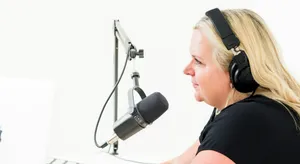Mar 18, 2025
How to Promote a Podcast: A Comprehensive Guide

Everyone who starts a podcast hopes others will tune in, enjoy, and spread the word. But with so many shows out there, it can feel tricky to stand out. This is where planning and consistency come into play. Just focusing on recording and editing might not be enough to draw a crowd. Sharing teasers, reaching out through social channels, and considering tools like #Podpacer can offer a big boost. Whether someone’s a total beginner or has a few episodes under their belt, these tips aim to foster real growth in a way that feels friendly and stress-free.
Understanding Your Audience
Getting a handle on who listens to your show is like figuring out what snacks your friends love before throwing a party. When a podcast matches the tastes and interests of the people tuning in, there’s a better chance they’ll stick around. They might even tell others who share that interest, which can lead to more downloads and followers. Some hosts skip audience research and rely on guesswork, but that often leads to episodes that don’t really connect. It’s almost like trying to guess someone’s birthday without asking a single question.
One part of researching is exploring social media comments or podcast reviews to see what folks enjoy. Maybe they like short episodes or can’t get enough of in-depth interviews. By spotting patterns in these comments, a host can shape episodes to fit those preferences. Another option is running polls on platforms like Instagram, asking listeners what they’d love to hear next. That’s often quicker than second-guessing behind the scenes. Collecting direct feedback also shows the crowd that their thoughts matter, which prompts them to speak up more often.
Many hosts decide on a “listener persona.” That’s basically a simple profile with details like age range, typical hobbies, or where they spend time online. This persona ends up guiding all sorts of decisions, like the best time to release episodes or the sort of guests to invite. Watching analytics is another angle. Podcast hosting services usually provide data about where listeners are located, how long they tune in, and the devices they use. While it might sound technical, those stats tell you if your episodes are too long or if a certain format is more engaging. Small tweaks based on those details can make a huge difference in watch times and audience loyalty.
Define Your Target Listener
It helps to imagine one specific person who would love your show. Maybe that person is in their early 30s, enjoys fitness podcasts, and likes episodes around 20 minutes long. By focusing on these details, it’s easier to decide which topics fit and which can wait for another day. Learn more about boosting listenership with unique podcast themes.
Engage with Your Current Audience
When folks interact with your show—maybe by leaving a comment or sending an email—responding quickly can really build connections. A short thank-you or a follow-up question lets them know they’re contributing to the show’s direction. Over time, that sense of inclusion can transform occasional listeners into regulars who spread the word.
Creating Compelling Content
No one wants to feel bored halfway through an episode. That’s why strong content is key. It doesn’t mean each episode must be jam-packed with fancy guests or mind-blowing secrets. It’s really about offering a mix of relevant insights, fun stories, and a natural flow. Good episodes often start with a clear plan: who’s talking, what’s the main topic, and how the discussion might wrap up. Listeners appreciate a show that feels present and well-organized, rather than something that rambles or loses them with off-topic tangents.
Some find it helpful to outline key points ahead of time. If an interview is on the schedule, hosts might jot down questions to keep things on track while allowing room for follow-up thoughts. Recording in a quiet space can improve audio quality, and that matters a lot. Fuzzy or crackly broadcasts can push people away, since they can’t hear the conversation clearly. Best audio editing software for podcasters can help remove long pauses, coughs, or repeated words, making the final cut smoother. It might sound like extra work, but crisp episodes often stand out when people are scrolling through podcast platforms.
Another trick is to inject personality. The voice of the podcast—whether calm, funny, or curious—helps listeners feel connected to the host. Sharing personal observations or telling relatable stories can spark that bond. Even if the show covers serious topics, a friendly delivery can keep folks tuning in every week. It’s also good to keep track of episodes that spark the most shares or reviews. This tells a host what resonates. Maybe comedic segments get more attention, or a certain type of guest interview generates buzz. By leaning into what’s popular, hosts can fine-tune future content and make it more shareable.
Optimize Episode Titles and Descriptions
An episode’s title is like a storefront sign—people glance at it to decide if they’ll come in. Snappy, clear titles that hint at what listeners will gain often have the most pull. A quick and lively description can also help. Mention the main points or any exciting guests, and avoid huge blocks of text that feel daunting.
Leverage Guest Appearances
Inviting guests can open the door to new audiences. Suppose you chat with a personal finance guru—fans of that expert might tune in, even if they’re brand-new to your show. A friendly nudge for them to share the episode on social media can also extend your reach. Everyone wins: the guest has a spot to share insights, and you connect with more listeners. Essential questions for podcast interviews can help make these conversations more engaging.
Utilizing Social Media
Many people scroll through social feeds every day. This makes social platforms a prime space for podcast promotion. Sharing short clips or teaser trailers can spark interest. If someone likes a snippet, they might tap over to the full episode. Quick behind-the-scenes photos or polls asking for topic requests also help you feel approachable. It can even be fun to post a humorous outtake or a single line that made you laugh during editing.
It’s smart to stick with one or two platforms instead of juggling too many at once. Some shows thrive on Twitter, especially if they feature quick discussions or current events. Others might pick Instagram because it’s image-friendly, perfect for quote graphics or story-based polls. Consistently posting at certain times makes it easy for followers to remember your show. You don’t have to spam, though. It’s enough to maintain a rhythm that keeps your podcast on people’s minds.
Contests or giveaways can be a cool way to reward loyal fans and draw in new ones. Offer something simple, like early access to an episode or a small prize for the funniest listener question. Throw in a requirement that participants share an episode or tag a friend, and you can see how quickly word spreads. Interacting with comments is just as important, because folks are more likely to return if they know their feedback matters. A high five or a simple thank-you in the comments can turn casual viewers into enthusiastic supporters.
Choose the Right Platforms
Each social space has a vibe. Instagram suits visual content like infographics or audiograms, while Facebook groups can be handy for deeper discussions. It’s good to watch how your audience reacts. If they’re not biting on LinkedIn, for instance, no need to force it. Focus on the spaces where your fans like to hang out.
Create Shareable Audiograms and Videos
Small audio snippets paired with a moving waveform can pique curiosity. Adding subheadings or captions is helpful, especially for people who browse on mute. A short clip that ends on a cliffhanger or a humorous note can prompt folks to check out the full episode.
Building a Podcast Website
A website acts like a home base for your show. It’s a single spot where people can learn about upcoming episodes, skim through old ones, and even read text summaries if they’re in a rush. Search engines also notice these pages, which can lead to more traffic. A simple layout that showcases your latest content and offers easy navigation is often enough. No need to pile on endless features if they’re not helpful. Instead, direct people to your newest or most popular episodes with a clear call-to-action.
Some hosts add a short blog for folks who prefer reading. Maybe you break down the key points from the week’s interview or share behind-the-scenes stories. This strategy can attract casual visitors who stumble upon your website, then realize you have a podcast that matches their taste. Short, practical posts can be enough to keep them browsing. Over time, they might subscribe for fresh content alerts.
Website design doesn’t have to be fancy. Many platforms let you drag and drop elements and then hit publish. Adding your show’s artwork, a brief bio, and links to major podcast players can help people find their preferred listening option. And if someone wants to share an episode with a friend, it’s nice to have a quick link ready. The goal is to make everything easy to locate, whether they’re on a computer or a phone. That level of convenience can improve the chances people will come back regularly.
Importance of SEO for Podcasts
A site that uses keywords around your show’s theme can appear higher in search results. If, for instance, your podcast covers baking tips, phrases like “easy bread recipes” or “baking basics” can guide new fans straight to your site. Learn more about podcast SEO tips for discoverability.
Incorporating Transcripts and Show Notes
Some listeners prefer to skim transcripts before deciding to tune in. Others might have hearing difficulties. Transcripts also give search engines more text to explore, which can improve your visibility. Including a short bullet list of the main topics covered in each episode helps visitors see if it’s something they’d enjoy.
Cross-Promotion Strategies
Teaming up with other content creators can multiply your reach without spending a lot. The idea is simple: swap mentions of each other’s shows or guest star on one another’s episodes. That way, new groups of people learn about your content and have a reason to check it out. It’s a give-and-take scenario that can lead to deeper collaborations down the road, like co-hosted events or joint newsletters.
It’s smart to look for podcasters with a similar theme or complementary angle. If your show is all about tech gadgets, linking up with someone who covers digital marketing might not be a perfect match—but if they have a chunk of overlapping listeners, it might still work. Listeners often trust hosts they already follow, so a recommendation carries weight. When they say, “Hey, check out this podcast,” many subscribers will do exactly that out of curiosity or loyalty.
Some hosts exchange short voice clips to play at the end of an episode. Others create a full crossover event where both feed the same conversation to their subscribers. When either approach prompts a spike in attention, it’s handy to watch the analytics to see if those new listeners stick around. If there’s a drop-off, it might mean the partner’s audience didn’t connect with your topic. That’s not a total loss, though. You can keep experimenting to find better matches.
Collaborate with Other Podcasters
A short appearance on someone else’s show can introduce you to new listeners in a natural way. If your conversation is lively, people might jump on your feed to see more of your content. Just be sure to return the favor, keeping the relationship friendly and fair. Learn more about boosting podcast engagement with controversial topics.
Network in Online Communities
Online spaces like Facebook groups or podcasting subreddits are good spots to meet potential partners. Many members there are searching for fresh episodes to plug or new voices to add to their lineups. Show genuine interest in their content instead of just spamming your own links, and you’ll likely build trust faster.
Leveraging Email Marketing
While social media can feel crowded, an email list is more direct. Messages land right in someone’s inbox, so there’s a greater chance they’ll open and read. This can be a great solution for those wanting to keep fans updated on the latest release schedule without getting lost in a sea of tweets or posts. Brief recaps of new episodes, or personal anecdotes about the show, can maintain a sense of connection. Midway through building your audience, consider taking advantage of #Podpacer to streamline tasks so there’s more time to craft thoughtful newsletters.
Emails can highlight upcoming guest interviews, ask for topic suggestions, or share little trivia bits. It’s also possible to add a personal greeting: “Hope your week’s been going well. If you need something to listen to on your commute, here’s the new episode!” That friendly note can make subscribers feel engaged. Some might even reply with ideas, feedback, or general encouragement. Those spur-of-the-moment messages can inspire future episodes or even spark bigger collaborations.
If a show asks for ratings or reviews, email is the perfect place to request them. People who are already subscribed tend to be more invested, so they’re often willing to help out. By gently suggesting, “We’d love your thoughts on our latest chat,” you might gather a handful of new reviews that push you higher in podcast charts. Email campaigns can also invite folks to join your social channels for more updates or exclusive Q&A sessions.
Start a Podcast Newsletter
A short, weekly or bi-weekly newsletter keeps fans in the loop about fresh episodes. Include quick bullet points on the main subjects, plus a direct link to listen. That way, if they’re short on time, they can see at a glance if it’s a topic they’re eager to hear.
Encourage Listener Feedback and Reviews
Review requests can go in the body of the email or a PS at the end. Let your audience know their say matters. If they leave a comment, you can mention it on a future episode. That makes them feel like part of the show’s inner circle.
Exploring Paid Advertising
Sometimes a show needs extra help reaching a broader audience. That’s where paid ads come in. By placing ads on podcast apps or streaming services, you can connect with listeners who are already browsing for something new to try. You can also run short audio spots that introduce your show’s theme and let folks know why it’s worth their time. This path isn’t free, but it can bring in dedicated listeners faster than waiting for organic growth.
Picking the right channel is important. Some hosts advertise on platforms like Spotify, where you can run a quick audio clip noticed by folks who love to explore fresh episodes. Others experiment with social media ads that pop up in targeted feeds. The good news is that many advertising dashboards let you customize who sees or hears the ad (e.g., based on interests in comedy, sports, or parenting). Checking metadata and performance stats is crucial so you’ll know if your money is well spent.
Budgeting thoughtfully avoids overspending. Some start with a small daily or weekly sum to gauge if the campaign is drawing in new listeners. They track clicks or downloads to confirm any spikes line up with the ad’s run. If it’s looking good, they might increase the budget. If not, they adjust the message or the audience targeting. A short, punchy script that highlights the show’s benefits can make your ad more effective. Mentioning big guests, fun episodes, or a unique angle might stop someone’s scroll or prompt them to crank up the volume.
Advertise on Podcast Apps
Several apps let you pay for featured slots, so your show might appear on a special list or in a banner. This is often a direct line to people who are already hunting for podcasts. Keep the wording concise and highlight what sets your episode lineup apart.
Utilize Spotify and Other Platforms
Spotify’s ad platform, in particular, enables hosts to record short spots that run in between tracks or other podcasts. This can capture attention when folks are in a listening mood. Make sure your ad is clear about where to find your show and what audience it’s for.
Monitoring and Adjusting Strategies
Bringing in more listeners is rarely a one-and-done deal. It involves regular checks on how many downloads an episode gets, which social posts gain traction, and what kind of reviews keep popping up. This ongoing look at data helps hosts figure out what’s working and what might need tweaking. Sometimes, a single element—like the length of episodes—can cause people to tune out early. With analytics, that pattern becomes visible.
A big part of refining an approach is experimentation. If shorter episodes see a sudden jump in downloads, maybe that format is a better match for the audience. Or if certain topics get triple the comments on social media, it might be worth focusing on those themes more often. Direct messages and emails from listeners can offer real insight, too. They might reveal that your explanations are super helpful or that the pacing feels rushed at times.
Data can feel dry, but it’s really just a set of clues for making things better. It’s okay if a social media push doesn’t break records, or if one specific interview flops. Learning from those experiences can lead to changes that resonate down the road. Each attempt, whether successful or not, builds knowledge about how your audience behaves and what draws them in. Consistent effort plus thoughtful adjustments often leads to steady, long-term growth, rather than short bursts that fizzle out.
Track Listener Data and Engagement
Check if people are tuning out of episodes at a certain timestamp or if they listen until the end. That info can shape how you plan future shows. Some podcast players show geographic data, which might reveal if you have a strong following in a certain region.
Refine Your Approach Based on Feedback
Listen to your community. Take notes on comments, reviews, and interview suggestions. If many folks mention they enjoy your lighthearted style, lean into that. If they say some parts are too long, consider tightening sections to hold attention.
Conclusion
Promoting a podcast is more than posting episode links and hoping for the best. It’s a steady balance of understanding what listeners want, staying active on the right platforms, and trying out ideas that make a show stand out. Every squiggly detail—from the first five seconds of an intro to the final sign-off—can shape whether someone returns week after week.
A multi-layered approach often helps. There’s audience research, thoughtful episode planning, social media campaigns, and cross-promotion. Email marketing adds a personal touch, and paid ads can speed things up if the budget allows. This broad mix works nicely for those who are determined to grow and maintain an audience. Checking data helps keep everything on course, since it shows what to keep doing and what to change. It might never be a perfect system, but small improvements add up in a big way.
When everything aligns, a podcast can capture the hearts and ears of listeners who stick around for the long haul. That’s when it becomes a real community, with fans who eagerly wait for each new release. Anyone looking to simplify the process might turn to #Podpacer for organized planning or repurposing content, allowing them to focus on creating episodes that resonate. With an open mind and a willingness to adapt, each step leads to stronger growth and a show that people can’t wait to recommend. Learn more about podcast promotion services that can help accelerate your growth.
Frequently Asked Questions (FAQ):
How do I promote my podcast?
• Share snippets on platforms like Instagram or Twitter.
• Use email newsletters for a direct line of communication.
• Team up with guests or other podcasters.
• Include relevant keywords in titles and descriptions for better search visibility.
How do I get 1000 listeners for my podcast?
• Start with high-quality content that keeps people coming back.
• Release episodes on a consistent schedule.
• Spread the word through social channels, and ask friends to share.
• Collaborate with other shows to tap into new audiences.
How can I promote my podcast for free?
• Share fresh episodes on social media pages and relevant groups.
• Offer guest spots or mention other podcasts for cross-promo.
• Encourage listeners to leave reviews.
• Engage in discussion forums where your target audience hangs out.
How do I make my podcast go viral?
• Pick share-worthy topics that spark emotion or solve problems.
• Use social media or influencer shout-outs to get noticed fast.
• Ask your audience to send the episode to friends.
• Focus on a strong hook in the first few minutes so listeners stay until the end.
Related Posts
See All Posts

Social Media for Podcasts: How to Build and Engage Your Audience
Podcasts have become part of everyday routines, offering stories and insights with just a tap. But with so many choices out there, finding t


Mastering Podcast SEO Techniques: A Comprehensive Guide
In a world where podcasts keep growing, getting noticed can feel like a climb. There's a bright side, though. [Learn more about boost podcas


Top Podcast Promotion Strategies for 2025
Plenty of podcast creators hope to stand out in a sea of audio content. With over two million shows available, it's essential to find new wa
No one knows your podcast like Podpacer
Podpacer is the best way to handle your podcast production. Manage your guests, research and plan your interviews, write social media content with one click, all in one place.


